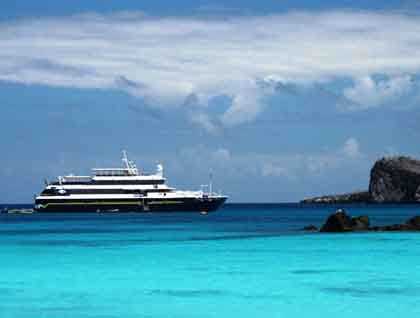Located in the southeastern corner of the Galapagos Archipelago, Española is one of the oldest islands. From the distance, it looks rather flat and very, very dry. The early morning was cloudy and breezy, but the air temperature was rather mild—we are near the equator after all!
A group of early risers set off before breakfast to practice some kayaking along the rocky coast of Gardner Bay. Slowly, the cloud cover disappeared and a marvelous blue sky was revealed just in time for our next activities. Right in the middle of the bay lays Gardner Islet, which is the perfect environment for our first snorkeling outing. With clear, blue waters our fearless snorkelers jumped in to swim amidst various species of fish like parrotfish, Mexican hogfish, and creole fish, as well as a few Galapagos sea lions which inhabit the islet. Other guests preferred to practice their skills at Gardner Beach. With its white, coralline fine sands and turquoise waters, this is one of the most stunning beaches of the Galapagos. A colony of Galapagos sea lions was not far from our novice snorkelers, and during our practice a couple of them kept on showing up, a clear sign of the natural curiosity of this endemic species. Española has its own endemic mockingbird, and all along the beach we could observe them as they constantly searched for food. They even checked inside backpacks and bags left unattended on the beach, which was rather amusing. We left the sea lions, the mockingbirds, and the beach behind and returned back on board, as by midday it was time to leave.
After a delicious typical Ecuadorian buffet lunch, we had a short time to prepare for our next excursion. We navigated further west along the northern coast of Española and dropped anchor at Punta Suárez, one of the most spectacular places in the archipelago. The areas around the “Punta,” or point, are very rich in nutrients, and therefore this portion of the coast has been colonized by various marine species. One of the most interesting ones is the unique marine iguana, a sea-going lizard that feeds exclusively on algae. It was fun to notice that as they are gathered in groups to absorb heat from the sun, most are aligned in the same direction. The trail took us through a couple of beaches where we found many sea lion pups, some as old as three months, others just a few days old. Along the inland trail we had close encounters with the endemic Española lava lizards, as well as land birds like the large cactus finch, warbler, and small ground finches as well as some Galapagos doves. We reached the territories of the waved albatross, the largest bird of the Galapagos that breeds exclusively on Española. Their breeding season is coming to an end, so we found several albatross chicks along the way, their adult plumages soon to be completed before they abandon the island by early January. The trail took us also through the colony of Nazca boobies, which had obviously initiated their annual breeding season: many couples were engaged in their courtships, or mating, and a few had already produced an egg.
The light became dimmer and the sun was soon to set so we returned back to our landing spot and then on board. It has been a fantastic day, and we have certainly enjoyed the serene beauty of this magical spot so far away from the “civilized” world. We cannot wait for the new adventures that wait for us tomorrow in Floreana Island.







